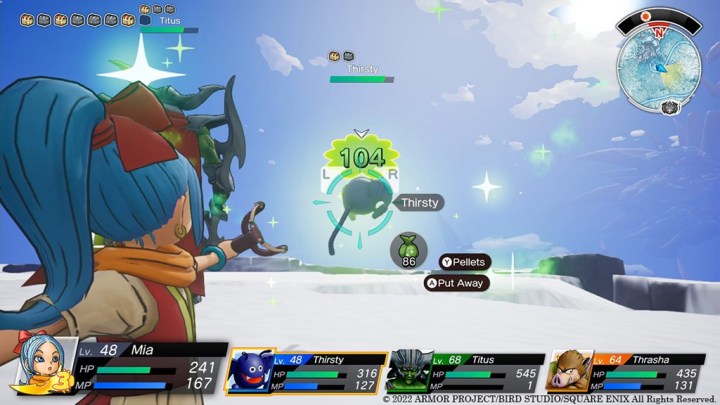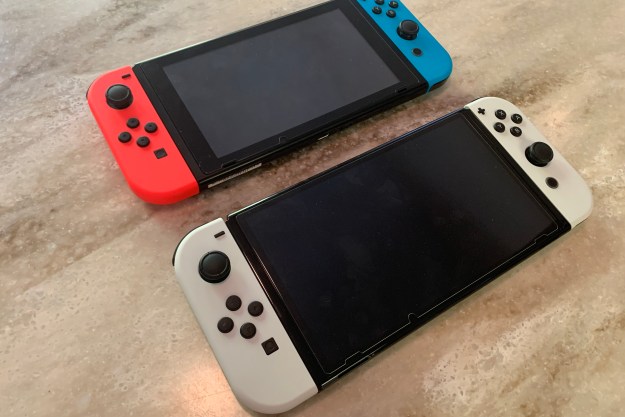
“Though its core treasure-hunting loop is tedious, there's a lot of charm worth digging up in Dragon Quest Treasures.”
- Fun treasure-hunting hook
- Lots to collect
- Detailed systems
- Diverse world design
- Repetitive flow
- Low quality of life
- Core combat is flat
Past, present, and future all come together in Dragon Quest Treasures. The treasure-collecting RPG is at once an old-school dungeon crawler that pays tribute to the franchise’s long history and a modern open-world game that acts as a complement to this year’s Pokémon Legends: Arceus. The intersection of those two ideas is at times messy, but there’s gold in those hills if you have the patience to pan for it.
The Switch exclusive is a spinoff of the more traditional RPG series, trading in turn-based combat for real-time action. Battles are only a small part of the adventure though, as its main loop revolves around tracking down and appraising valuable collectibles with the help of some monster pals. It’s a low-stakes experience that’s well-suited for portable play, though one that doesn’t skimp on complexity — a decision that creates some tension in an otherwise laid-back concept.
Dragon Quest Treasures sports an addictive central hook that’s made tedious due to overcomplicated design decisions that leave it feeling antiquated among its peers. While that makes it a hard game to widely recommend, I still found myself charmed by this relaxing all-ages adventure that puts a lot of effort into everything it sets out to do.
Buried treasure
Dragon Quest Treasures is positioned as a prequel to Dragon Quest XI: Echoes of an Elusive Age, but it’s more of its own bottle story. It stars younger versions of Mia and Erik from that title, siblings with a passion for treasure hunting. After an encounter with a pair of magical daggers, they’re whisked away to the land of Draconia, a series of islands filled with riches. That includes seven Dragonstones that they’re tasked with collecting before the fearsome Long John Silverbones can do the same.

While it looks like a soft kids game, Treasures can be surprisingly overwhelming at first. It’s loaded with systems like crafting, cooking, vault management, and monster collecting on top of your usual RPG hooks. Its core loop becomes straightforward after a few hours, though. Players load into one of five mini open biomes and scour for buried treasure using a compass. When a treasure is close, the compass will provide a few photographs hinting at where exactly it is, allowing them to dig it up. It’s essentially a light scavenger-hunting RPG that plays like a dungeon crawler with a decreased emphasis on combat.
Once I settled into that flow, I found it easy to get lost in its chill exploration groove. I got a little dopamine hit every time I discovered a glowing treasure spot. I’d excitedly dig up as many chests as I could hold at one time, trying to make the most of an excursion before returning to my home base to get my findings appraised. For those who loved Pokémon Legends: Arceus, Dragon Quest Treasures captures that same sense of open-ended adventure, as well as its enticing collection aspect.
That core idea is made much more rewarding due to the fact that each treasure is a reference to Dragon Quest’s history. The more treasure players find, the more they’re building a museum celebrating the series. Even as someone who isn’t as versed in the RPG franchise’s deep history, I always got a little kick out of seeing its eclectic worlds transformed into trophies I could display in my home base.
Dragon Quest Treasures makes me feel like a little kid digging for cool rocks in the woods and taking them back to my tree fort.
All of that feeds into a vault management system, which almost feels like a delightful Nintendo 3DS StreetPass minigame. The more treasure players collect and display on plinths, the more the value of their vault increases. That, in turn, levels their collection rank, which increases passive buffs like the number of stat-boosting medals players can equip. Bases will even get raided by NPC gangs from time to time, tasking them with fighting back invaders to protect their stash and increase its value in the process. Each system loops into one another, putting me in a natural rhythm as I switch between item hunting and base management.
In its best moments, Dragon Quest Treasures makes me feel like a little kid digging for cool rocks in the woods and taking them back to my tree fort. It’s the right spirit for a good-natured game like this that I expect younger players especially will click with.
Quality of life
Though I appreciate how intricately constructed Treasures is, its core hook does get tedious. While there are unique quests and story beats along the way, most of the adventure revolves around making enough treasure runs to grind out your rank, which gates story progression. Item hunting can get monotonous after a while, as players essentially just wander around until they find a glowing spot and then hold the A button for a few seconds to unearth something.
Even the littlest systems have a bit of tedium sprinkled in.
That already repetitive flow is compounded by a slew of frustrating design decisions that build on each other. For instance, players only bank their treasures by returning to one of a few train stations scattered throughout each world — the majority of which need to be unlocked with resources whose locations are unmarked and random. There’s no fast travel available from the map, leaving players to sometimes make a long trek back to a train station to get home (or burn a limited item that teleports them back home safely). If a powerful monster happens to wipe out a player’s party on the way back, they’ll be booted to their last save, potentially losing everything. It’s all likely intended as a risk-reward system, but it winds up feeling archaic for the genre.
None of this would be so much of a problem if traversal was fun and fluid, but that’s the area where Treasures struggles most. Along the journey, players recruit creatures like slimes, which each have one of a few fortes. Some are basic abilities that enable them to run, glide, or bounce to reach high surfaces. Others are more context-specific, like a digging tool that gives easy access to some hidden spaces. Since a party can only contain three monsters at a time, that means players can’t access all their traversal tools at once. Party members can only be swapped at the base, so if you come across a dig site. but don’t have that monster on hand, you’ll need to trek back to a train station, equip something with that forte, and head back out.
A lot of extra decision-making is placed on party choice, though. Each has its own specific attacks in battles, can carry a certain amount of treasure, and even increase the odds of treasures showing up around the world. When I set out on an expedition, I’m forced to weigh which of those critical utilities are most important. I ultimately wound up spending most of the game just equipping my highest-level buddies with glide, sprint, and jump that felt too fundamental to give up. It brings me back to the days of Pokémon Red and Blue, where I’d need to keep monsters with certain HMs in my party even if I didn’t really want to use them in battle — something that series has long outgrown.

Even the littlest systems have a bit of tedium sprinkled in. The sprint forte, for instance, can only be used for a limited amount of time. When its use bar runs out, it has to go through an irksome cooldown before it can be used again. The time a forte can be used sometimes increases with treasure rank, but never to the point where I could freely roam the worlds at a quicker pace. Item gathering gets old fast too, as a lack of auto pickup means players have to sit through a bending animation with each item they pick up — and this world is densely populated with resources. And don’t get me started on overused monster voice lines (get ready to hear the same few “slime” puns hundreds of times) that play over and over while exploring, giving the Xenoblade Chronicles 3 crew a run for their money.
Much of this might sound like nitpicking, but every small annoyance adds up when you’re doing the same things over and over again. There’s a strong core idea here, but Dragon Quest Treasures is a game that’ll benefit from a tightened sequel that takes the right lessons from peers like Pokémon Legends: Arceus.
Still a charmer
Even with all my gripes — ones that would have me recommending this to others with a lot of caution — I still found myself charmed by Dragon Quest Treasures overall. Part of that comes from its soft aesthetic, full of smooth shapes and bright colors. It’s no tech powerhouse, but I appreciate how much work has gone into creating each of its diverse islands. While even some of the Switch’s best open-world games tend to offer flat locations that reuse some muddy earth tones and textures, there’s so much extra detail here that makes spaces feel special. A desert area has me crossing floating islands with my glide forte before descending some skeletal steps into a lower area. Another swampy location has me scaling a massive spiral tower as I hunt for riches.
It aims to deliver a low-stakes exploration with a childlike imagination, which shines through in a sometimes dirty sifting pan.
Dragon Quest Treasures puts that level of effort into everything it does, even its otherwise simplistic ideas. The streamlined approach to combat is a strong example of that in action. Players are constantly flanked by their team of three monsters (slimes, golem, and more Dragon Quest staples), which auto attack any enemy in sight. Mia and Erik can’t really command them outside of spending dagger points to unleash a special attack. Instead, they have a single slash attack that can be spammed. Like the treasure-hunting hook, it wears thin after the hundredth time doing it, but extra touches help some of its more involved boss battles stay engaging.
For instance, Mia and Erik can use a slingshot that comes with dozens of ammo types, from elemental attacks to healing pellets. That little addition brings just a touch of battlefield management that grants players more options in what otherwise plays out like a mindless auto-battler.

Several systems like that had me surprised by the ways the adventure layers in depth without overcomplicating itself. Simple daily quests provide a reason to log on every day, medals allow players to customize their team’s stats, the home base can be expanded with shops, and monsters can be sent out on expeditions to gather resources on their own. Even after beating it, I’m still left with plenty to do if I ever decide to revisit Draconia.
Dragon Quest Treasures fumbles some key details, creating an at times frustratingly tedious RPG, but its heart is always in the right place. It aims to deliver a low-stakes exploration with a childlike imagination, which shines through in a sometimes dirty sifting pan. For younger players or even older ones who fondly remember pretending to be a pirate as a kid and don’t mind the tedium, Erik and Mia’s adventure is a comforting return to the sandbox.
Dragon Quest Treasures was tested on a Nintendo Switch OLED in handheld mode and on a TCL 6-Series R635 when docked.
Editors' Recommendations
- Dragon Quest Treasures shows off monster-catching gameplay
- Dragon Quest XII and 5 more games announced at franchise’s anniversary stream
- Dragon Quest Walk is a new location-based mobile AR game similar to Pokémon Go



